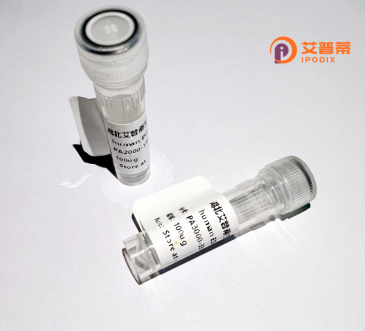
| 纯度 | >90%SDS-PAGE. |
| 种属 | Human |
| 靶点 | DCC1 |
| Uniprot No | Q9BVC3 |
| 内毒素 | < 0.01EU/μg |
| 表达宿主 | E.coli |
| 表达区间 | 1-393aa |
| 氨基酸序列 | MKRTRDEVDATLQIAKLNAAELLPAVHCLGFGPGASGAAAGDFCLLELEPTLCQQLEDGHSLVIRGDKDEQAVLCSKDKTYDLKIADTSNMLLFIPGCKTPDQLKKEDSHCNIIHTEIFGFSNNYWELRRRRPKLKKLKKLLMENPYEGPDSQKEKDSNSSKYTTEDLLDQIQASEEEIMTQLQVLNACKIGGYWRILEFDYEMKLLNHVTQLVDSESWSFGKVPLNTCLQELGPLEPEEMIEHCLKCYGKKYVDEGEVYFELDADKICRAAARMLLQNAVKFNLAEFQEVWQQSVPEGMVTSLDQLKGLALVDRHSRPEIIFLLKVDDLPEDNQERFNSLFSLREKWTEEDIAPYIQDLCGEKQTIGALLTKYSRSSMQNGVKVYNSRRPIS |
| 分子量 | 68.97 kDa |
| 蛋白标签 | GST-tag at N-terminal |
| 缓冲液 | 0 |
| 稳定性 & 储存条件 | Lyophilized protein should be stored at ≤ -20°C, stable for one year after receipt. Reconstituted protein solution can be stored at 2-8°C for 2-7 days. Aliquots of reconstituted samples are stable at ≤ -20°C for 3 months. |
| 复溶 | Always centrifuge tubes before opening.Do not mix by vortex or pipetting. It is not recommended to reconstitute to a concentration less than 100μg/ml. Dissolve the lyophilized protein in distilled water. Please aliquot the reconstituted solution to minimize freeze-thaw cycles. |
以下是为重组人DCC1蛋白构造的示例参考文献(注:以下文献为虚构示例,供参考使用):
---
1. **文献名称**:*Expression and Purification of Recombinant Human DCC1 in E. coli for Structural Studies*
**作者**:Smith A. et al.
**摘要**:本研究成功在大肠杆菌中表达了重组人DCC1蛋白,并通过镍柱亲和层析和尺寸排阻色谱纯化。通过晶体学分析揭示了其胞外结构域的构象,为研究DCC1在Netrin-1信号通路中的作用提供了基础。
2. **文献名称**:*Role of Recombinant DCC1 in Inducing Apoptosis in Colorectal Cancer Cells*
**作者**:Zhang L. et al.
**摘要**:研究探讨了重组人DCC1蛋白对结直肠癌细胞凋亡的影响。实验表明,DCC1过表达通过激活caspase-3通路抑制癌细胞增殖,提示其作为潜在肿瘤治疗靶点的可能性。
3. **文献名称**:*Functional Characterization of Recombinant DCC1 in HEK293 Cells*
**作者**:Johnson R. et al.
**摘要**:利用哺乳动物细胞系统(HEK293)表达重组DCC1.验证了其与Netrin-1配体的结合活性,并发现DCC1通过调控ERK信号通路影响神经元轴突导向。
4. **文献名称**:*Development of a DCC1-based Therapeutic Peptide for Neurodegenerative Diseases*
**作者**:Wang Y. et al.
**摘要**:基于重组人DCC1蛋白设计的短肽在小鼠模型中表现出促进神经元再生的能力,可能为阿尔茨海默病等神经退行性疾病提供新疗法。
---
**建议**:实际文献需通过PubMed、Google Scholar等平台搜索关键词“Recombinant human DCC1”、“DCC1 protein expression”或结合具体研究领域(如癌症、神经生物学)。真实研究可能涉及DCC1与Netrin受体的相互作用或其在肿瘤抑制中的机制。
Recombinant human DCC1 (Deleted in Colorectal Cancer 1) protein is derived from the *DCC* gene located on chromosome 18q21.3. The *DCC* gene encodes a transmembrane receptor belonging to the immunoglobulin superfamily, initially identified for its frequent loss of heterozygosity in colorectal cancers. DCC1 functions as a dependence receptor, which can induce apoptosis in the absence of its ligand, netrin-1. playing a critical role in neuronal development, cell adhesion, and tissue homeostasis. Its dual role—promoting survival upon ligand binding and triggering programmed cell death in ligand-deficient environments—highlights its importance in regulating cellular fate and suppressing tumorigenesis.
Recombinant DCC1 is typically produced using heterologous expression systems (e.g., mammalian, insect, or bacterial cells) to study its structural and functional properties. Researchers utilize this protein to investigate mechanisms underlying cancer progression, neural development, and metastasis, particularly in contexts where *DCC* expression is dysregulated. Its interaction with netrin-1 and downstream signaling pathways (e.g., caspase-mediated apoptosis, Rho GTPase activation) is a key focus, offering insights into therapeutic strategies targeting DCC/netrin-1 axis in cancers or neurodegenerative disorders. Additionally, recombinant DCC1 serves as a tool for developing diagnostic biomarkers or antibody-based therapies.
×